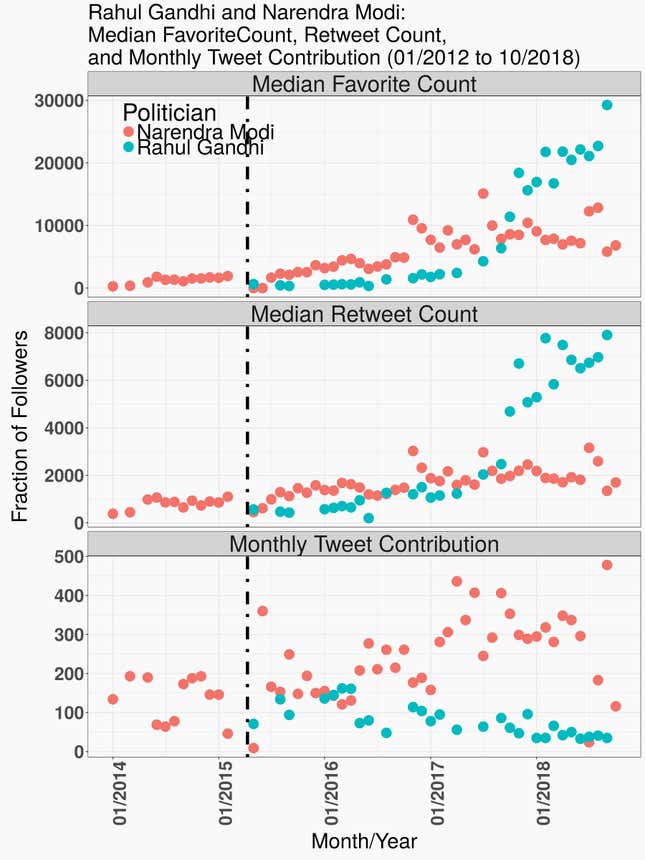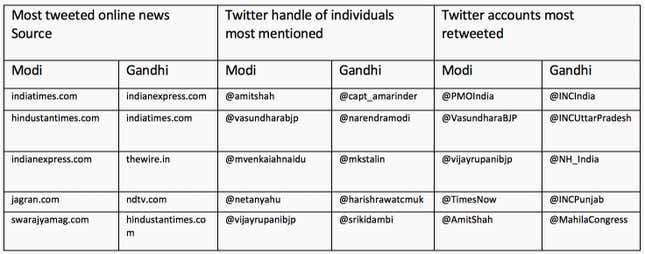“Is Rahul Gandhi stupid?”
“Of course.”
“Why so?”
“I’ve seen his speeches.”
“Have you ever seen an entire speech?”
“No.”
I tried this conversation over and over, to get at the ways in which a brand image gets attached to an individual political actor over time.
Till mid-2015, the Congress party was markedly aloof on direct social media engagement. During the same period, “Pappu” jokes became virtually ubiquitous on the average feed for most social media users in India. The idea of an anointed aristocrat is fundamentally unpalatable to a technology-enabled middle class hypersensitive to the feudal stick. And few things offer better affective reinforcement than mockery.
Selectively edited videos and cleverly worded memes were broadcast, liked, and forwarded through networks of people. Tweets, including those by key leaders, repeated the terms Rahul Baba, Pappu, and Shahzada, dismissing any credibility he had as an independent-thinking political leader, let alone as a plausible rival to arguably the most formidable Indian political figure in decades.
In 2014, the campaign against Gandhi was widespread and decentralised. The Pappu jokes came from a wide variety of folk, even those for whom it wasn’t a gateway drug into the Bharatiya Janata Party (BJP). Yet the message was one of harmonious derision. Just as the digital Gandhi was infantile, a fool, and a tool, the digital Narendra Modi was a barrel-chested, efficient, self-made technocrat.
By 2018, a lot has changed. While the BJP still maintains pole position in terms of online footprint, several parties have created their own pockets of political power online. Pappu jokes still resonate, but Gandhi is also the most followed opposition figure online, fast racing towards the “How I learnt to stop worrying…” innuendo among people who once found it inconceivable to consider him their preferred leader.
The two leaders had significantly different growth trajectories online. Modi was an early adopter of social media, at a time when Shashi Tharoor was the only game in town in a technology that was largely a Western, English-only outlet for banalities and pithy aphorisms.
In that, Modi saw the trend that was to emerge.
He had a gradual growth in following and messaging from 2009 on, catching steam in 2013, and then gaining massive following post the 2014 election. Gandhi, with much of the Congress party in general, woke up to social media late, having no presence online till 2015. He initially started the Twitter handle with the decidedly awkward third-person handle “@OfficeofRG,” eventually transitioning to the more direct-speaking “@RahulGandhi.”
Today, with around 45 million followers, Modi is well ahead of Gandhi whose following clocks in at less than a fifth of the prime minister’s. Modi is also much more prolific in terms of output. While he tweeted almost 300 times a month on average in 2017-18, Gandhi averaged just over 50 tweets a month through the same period. But there is more to the story than that dominating footprint.
Trading places
A fundamental shift happened in the latter half of 2017 that has made Gandhi a serious contender for mindspace online. As we see in figure 1, from being largely insignificant in terms of his message retweet rates for much of his first two years on Twitter, Gandhi started getting significantly more attention for his tweets despite his exponential disadvantage in core following.

There can be a range of reasons for this change.
Retweets and likes are a crude measure of actual popularity, since they do not account for the extent of retweeting by the same sets of dedicated followers, of bots, or accounts that act on behalf of others. It is difficult to measure exactly how much of this is represented in this popularity. What we do know, however, is that Gandhi’s tone has changed dramatically.
Rather than object to the ridicule online, Gandhi moved from generic tweeting on national issues to an all-out aggressive tone, frontally insulting Modi as well as his core group of advisors, including Amit Shah and Arun Jaitley.
This is a departure from the past history of Congress presidents, particularly Sonia Gandhi, who preferred to keep the public discourse civil and understated, though, unlike them, Rahul Gandhi also inherits the most disadvantaged position that the Congress has ever been in throughout India’s independent history.
A case in point: The term Shahzada, once used by Modi to belittle the Gandhi scion, has effectively been turned around by Gandhi to refer derisively to Jay Shah, Amit Shah’s son, in reference to corruption allegations. A look at the word-clouds of the hashtags most used by Gandhi shows the emphasis on attacking notes, including the Rafale issue as well as criticising the government in Gujarat.

In contrast, Modi’s most used hashtags between 2017 and 2018 show a very different message. As opposed to the Modi of 2014, who at once attacked the incumbent government and spoke extensively about a development vision, the late-term Modi focuses on two things: a feel-good message, and Modi himself. The most common hashtags he uses are about sports and health, but Modi’s own “Mann ki Baat” missives occupy centre stage. Unlike Gandhi reframing himself as a snarky challenger willing to go frontally against the Goliath, Modi increasingly moves from political leader to all purpose patriarchal guru, moving from pithy aphorisms to being a full-on life coach, with thoughts of national relevance on fitness, exams, and a litter-free republic.

From pariah to contender
Online, the Congress party has started galvanising around Gandhi. The extent of centralisation of party discourse around Gandhi is evident in the gradual increase of retweets of his messages by other party members. We aggregated 2.3 million tweets from 2017-18, from 417 Congress and 779 BJP politicians, and found a consistent increase in the number of retweets of messages by Gandhi since 2017.
A more important indicator of Gandhi’s success is in the ruling party’s new attention to him. A look at the extent to which politicians in the Congress and BJP mention Gandhi and Modi reveals interesting trends in who the party members are talking about. We see that although Modi is a dominant part of the discussion in both the BJP and Congress through the entire period, BJP politicians have had a gradual increase in their mention of Modi, suggesting a slow centralisation of the discourse around the prime minister. On the other hand, the Congress politicians have aggressively increased the extent to which they mention their own leader, from barely mentioning him till mid-2017. While Modi still leads Gandhi in mentions in both parties, the actual handle @RahulGandhi has been more referenced than the handle @narendramodi by Congress members since January 2018.
We also see that since early 2018, roughly a quarter of all BJP politicians on Twitter have mentioned Gandhi. While these mentions are invariably negative on both sides, Gandhi was never mentioned by the vast majority of BJP politicians till 2017, arguably suggesting he was then considered insignificant. As the data shows, by 2018 this has changed, and BJP politicians increasingly see the need to address Gandhi.

The change that most marks Gandhi’s evolution online is the aggressive turn he has made since mid-2018. A look at the two leaders’ most popular English-language tweets shows us how the two leaders’ digital presences have changed. Modi, once known for his acerbic wit and attacking demeanour aimed at the Congress, has moved largely to positive-themed output and health-related messaging: the most retweeted message from the study period is one of Modi highlighting exercises. During the same period, we see a highly retweeted sarcastic message from Gandhi, which suggests that Modi obsesses over publicity gestures such as hugs while the foreign policy battle with the US is being lost.
It is also worth noting that while Gandhi’s average tweet out-retweets Modi’s average tweet, when Modi’s tweets do go viral, he has much more momentum with “likes” with his massive following. Case in point, Modi’s exercise tweet was favourited almost 100,000 times.
Gandhi’s embrace of his underdog status may have served him well online. The aloofness that has traditionally marked the Gandhi family as above contenders helped cement the loathsome aristocratic vibe. But now, Gandhi, clearly in the disadvantaged position, is an open target of online bullying, and almost seems to have accepted it. While the outcome of the online battle may have little to do with how the actual election turns out, the stage is set for drama that retweeters and their friends are ready to get sucked into.
And yet, the deeper troubling trend we see with both leaders is their reduction in interaction with mainstream press. Both Gandhi and Modi rarely interact with the mainstream press. At this point, Modi sends more retweets with links to YouTube or SoundCloud, largely his own communications, than he does to all mainstream media sources combined. This, if anything, is the most important trend in this story. Leaders have effectively moved over to communicating directly with little or no interaction with the mainstream media that is meant to act as a political watchdog for society.
For now, we hope a politician retweets us.

We welcome your comments at ideas.india@qz.com
